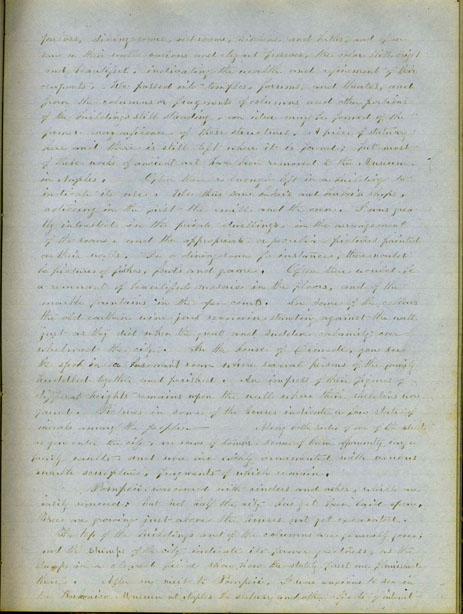 |
parlors,
dining rooms, bedrooms, kitchens and baths, and often saw on their walls
various and elegant frescoes, the color still bright and beautiful, indicating
the wealth and refinement of their occupants. We passed into temples, forums,
and theatres, and from the columns or fragments of columns and other portions
of the buildings still standing, an idea may be formed of the former magnificence
of these structures. A piece of statuary here and there is still left where
it is found; but most of these works of ancient art have been removed to
the Museum in Naples. Often there is enough left in a building to indicate
its use. We thus saw baker’s and barber’s shops, noticing in
the first the mill and the oven. I was greatly interested in the private
dwellings, in the arrangement of the rooms, and the appropriate or peculiar
pictures painted on their walls. In a dining room for instance, there would
be pictures of fishes, fowls, and game. Often there would be a remnant of
beautiful mosaic in the floors, and of the marble fountains in the open
courts. In some of the cellars the old wine jars remain standing against
the wall just as they did when the great sudden calamity overwhelmed the
city. In the house of Diomede, we see the spot in a basement room where
several persons of the family huddled together and perished. An impress
of their figures of different heights remains upon the wall where their
skeletons were found. Pictures in some of the houses indicate a low state
of morals among the people. Along both sides of one of the streets as you
enter the city, are rows of tombs. Some of them apparently large family
vaults, and were once richly ornamented with curious marble sculptures,
fragments of which remain.
Pompeii was covered with cinders and ashes, which are easily removed; but
not half the city has yet been laid open. Trees are growing just above the
houses not get excavated.
The top of the buildings and of the columns are generally gone; and the
stumps of the city indicate its former greatness, as the stumps in a cleared
field show how the stately first one flourished there. After my visit to
Pompeii, I was anxious to see in the Barkonico Museum at Naples the statuary
and other objects of interest.
|
